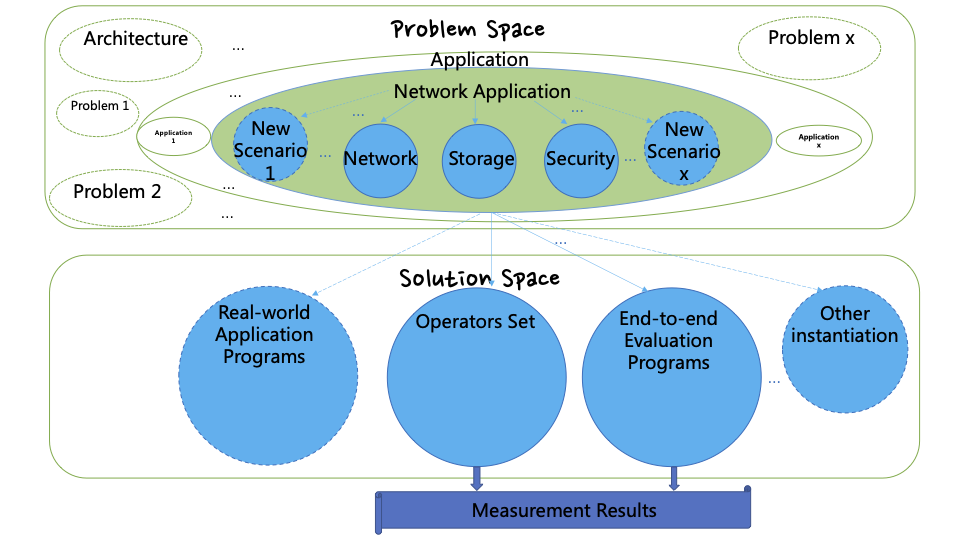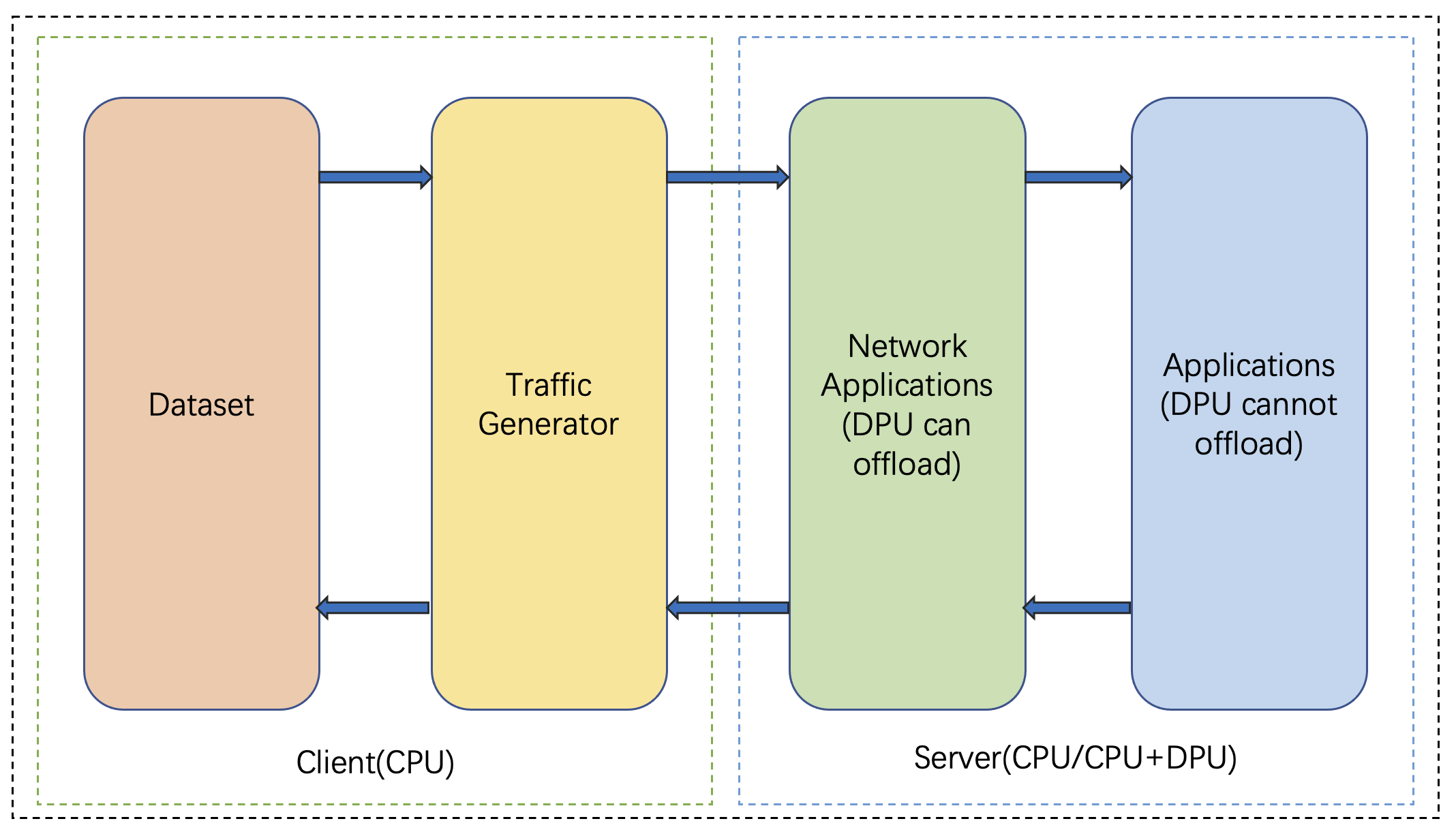Publication
DPUBench has been accepted in BenchCouncil Transactions on Benchmarks, Standards and Evaluations (TBench) 2023.
Zheng Wang, Chenxi Wang, and Lei Wang. "DPUBench: An Application-Driven Scalable Benchmark Suite for Comprehensive DPU Evaluation." BenchCouncil Transactions on Benchmarks, Standards and Evaluations (2023): 100120.
If you use DPUBench, please cite:
@article{wang2023dpubench,
title={DPUBench: An application-driven scalable benchmark suite for comprehensive DPU evaluation},
author={Wang, Zheng and Wang, Chenxi and Wang, Lei},
journal={BenchCouncil Transactions on Benchmarks, Standards and Evaluations},
pages={100120},
year={2023},
publisher={Elsevier}
}
Summary
With the development of data centers, network bandwidth has rapidly increased, reaching hundreds of Gbps. However, the network I/O processing performance of CPU improvement has not kept pace with this growth in recent years, which leads to the CPU being increasingly burdened by network applications in data centers. To address this issue, Data Processing Unit (DPU) has emerged as a hardware accelerator designed to offload network applications from the CPU. As a new hardware device, the DPU architecture design is still in the exploration stage. Previous DPU benchmarks are not neutral and comprehensive, making them unsuitable as general benchmarks. To showcase the advantages of their specific architectural features, DPU vendors tend to provide some particular architecture-dependent evaluation programs. Moreover, they fail to provide comprehensive coverage and can not adequately represent the full range of network applications. To address this gap, we propose an application-driven scalable benchmark suite called DPUBench. DPUBench classifies DPU applications into three typical scenarios - network, storage, and security, and includes a scalable benchmark framework that contains essential Operator Set in these scenarios and End-to-end Evaluation Programs in real data center scenarios. DPUBench can easily incorporate new operators and end-to-end evaluation programs as DPU evolves.
Motivation
Table1: The overview of representative existing DPU evaluation studies.

Table1 has provided a brief introduction of representative existing DPU benchmarks or evaluation programs, all of which are used for one specific DPU or DPU with one specific architecture. However, there is currently no DPU benchmark that can effectively evaluate DPUs with different architectures, which is a significant gap in the field. Furthermore, DPU architecture is rapidly evolving due to the increasing CPU computing resources that need to be offloaded in data centers, resulting in significant differences in DPU architectures between different DPU manufacturers or even the adjacent generations of the same manufacturer. Therefore, a scalable DPU benchmark that can evaluate DPUs of different architectures is needed, and it should be able to support the addition of new evaluation programs and metrics to accommodate the rapid development of DPUs.
Another motivation behind DPUBench is to ensure the representativeness and coverage of the benchmark suite, as well as the effectiveness and reliability of the evaluation results. In terms of coverage, the benchmark programs should not only be at a certain scale to handle basic network application scenarios but also not impose excessive evaluation costs in terms of time and resource utilization. Additionally, to ensure the reliability of the evaluation results, network-related metrics should be carefully selected, and DPUs should be evaluated in a real network environment within data centers.
Methodology
Figure1: The overview of DPUBench.

To construct DPUBench, we divide the process into problem space and solution space and implement it step by step in these two spaces. Our methodology for DPUBench is illustrated in Figure.1, which includes problem definition, problem instantiation, solution instantiation, and measurement results. This methodology is inspired by Zhan's benchmark science methodology of problem definition, instantiation, and measurement. By providing a clear and detailed description of each step in the construction of DPUBench, our methodology makes it easy to develop, maintain, and update. The solution instantiation of DPUBench involves the extraction and implementation of basic operators from network, storage, and security scenarios, which compose the DPUBench's Operator Set for DPU evaluation. We also implement end-to-end evaluation programs to conduct DPU evaluation in a real network environment. Operators represent the most common algorithms in these three scenarios, and their combination can construct typical programs in each scenario. The end-to-end evaluation programs simulate the business of a real data center machine and evaluate the performance of DPU in a real network environment through communication between the Client and Server. We do not include a separate application set in DPUBench because the main execution part of application programs can be implemented with operators combination, and their evaluation cost is higher compared to operators, as well as their evaluation results are less reliable and effective compared to end-to-end evaluation programs.
Operator Set
Table2: The Operator Set of DPUBench.

Table2 presents all the operators implemented in DPUBench, from the scenarios of network, storage and security as the methodology discussed. To evaluate the representativeness, diversity, and coverage of the workload characteristics of Operator Set in DPUBench, we have selected 6 real workloads from the network, storage, and security scenarios for comparison. These selected workloads are representative application programs that are primarily offloaded by the DPU or essential components in real network applications. Each workload can be implemented using the combination of operators in DPUBench. The detailed information on these workloads, along with their corresponding operators, is presented in Table3.
Table3: Selected real workloads.

End-to-end Evaluation Programs
Figure2 shows the framework of End-to-end Evaluation Programs in DPUBench, consisting of a Client with a dataset and traffic generator and a Server with applications that DPU can offload and cannot offload. Client device only contains CPU and is used for generating and sending data to the network. The server device can be a node that only contains a CPU or a node contains both CPU and DPU in data centers. The server receives and processes data packets sent by the Client, and transmits the results to the Client through the network.
Figure2: The Framework of End-to-end Evaluation Programs in DPUBench.

We have implemented two end-to-end DPU workloads in DPUBench. The first workload focuses on evaluating the performance of offloading the flow table to the DPU. This process is crucial as it enables the implementation of various network applications such as Packet Filters, Quality of Service, and Load Balancing. And the second end-to-end DPU workload closely resembles a real application structure.
Download
DPUBenchContributors
Zheng Wang, ICT, Chinese Academy of Sciences
Chenxi Wang, ICT, Chinese Academy of Sciences
Dr. Lei Wang, ICT, Chinese Academy of Sciences
DPUBench is open-source under the Apache License, Version 2.0. Please use all files in compliance with the License. Our DPUBench Software components are all available as open-source software and governed by their own licensing terms. If you want to use our DPUBench you must understand and comply with their licenses.
THIS SOFTWARE IS PROVIDED BY THE COPYRIGHT HOLDERS AND CONTRIBUTORS “AS IS” AND ANY EXPRESS OR IMPLIED WARRANTIES, INCLUDING, BUT NOT LIMITED TO, THE IMPLIED WARRANTIES OF MERCHANTABILITY AND FITNESS FOR A PARTICULAR PURPOSE ARE DISCLAIMED. IN NO EVENT SHALL THE ICT CHINESE ACADEMY OF SCIENCES BE LIABLE FOR ANY DIRECT, INDIRECT, INCIDENTAL, SPECIAL, EXEMPLARY, OR CONSEQUENTIAL DAMAGES (INCLUDING, BUT NOT LIMITED TO, PROCUREMENT OF SUBSTITUTE GOODS OR SERVICES; LOSS OF USE, DATA, OR PROFITS; OR BUSINESS INTERRUPTION) HOWEVER CAUSED AND ON ANY THEORY OF LIABILITY, WHETHER IN CONTRACT, STRICT LIABILITY, OR TORT (INCLUDING NEGLIGENCE OR OTHERWISE) ARISING IN ANY WAY OUT OF THE USE OF THIS SOFTWARE, EVEN IF ADVISED OF THE POSSIBILITY OF SUCH DAMAGE.